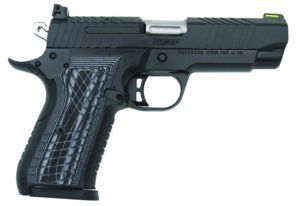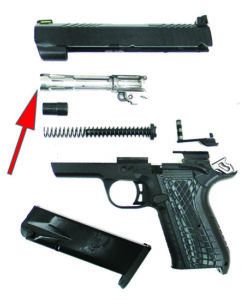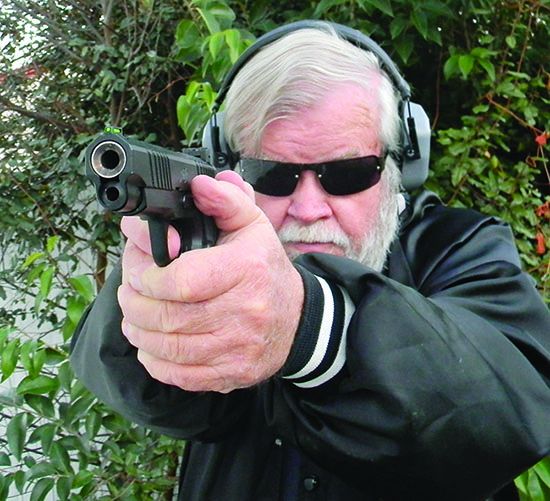The most popular carry gun in America is a polymer-frame striker-fired 9mm. While the smaller slim-line 9mms sell the most, larger pistols, such as the SIG P365, Smith & Wesson Shield Plus, and the Glock 19, nevertheless maintain strong followings. Here, we are looking at 9mm pistols in this larger footprint, including a:
● Shadow Systems MR920 Elite SS-1009, $979;
● Wilson Combat Vickers Edition Glock 19 upgrade, $1375; and a
● Kimber KDS9C 3100010, $1318, a Commander-length 1911. Here’s what we thought of them:
Kimber KDS9C Black 31000109mm Luger,
$1318
Gun Tests grade: B
We liked the Kimber a lot, especially the 1911 fans among the raters. The pistol is reliable, never failing to feed, chamber, fire, or eject. The Kimber lacks a combat-light mount; the optics set up is limiting, and the gun is set up for right-hand shooters only due to the single-side safety.

| Action Type | Single action, hammer fired |
| Overall Length | 7.75 in. |
| Overall Height | 5.32 in. |
| Maximum Width | 1.3 in. |
| Weight Unloaded | 28.0 oz. |
| Weight Loaded | 33.0 oz. |
| Slide | Kimpro-coated stainless steel |
| Slide Retraction Effort | 14.9 lbs. |
| Receiver | Aluminum alloy |
| Front Strap Height | 2.5 in. |
| Rear Strap Height | 3.4 in. |
| Barrel Length | 4.09 in. |
| Grip Material | G10 |
| Grip Thickness | 1.25 in. |
| Grip Circumference | 5.75 in. |
| Magazines | (2) 15 round |
| Rear Sight | Fixed |
| Front Sight | Fiber Optic, fixed |
| Trigger Pull Weight | 4.1 lbs. |
| Trigger Span | 2.65 in. |
| Sight Radius | 6.9 in. |
| Safety | Manual Slide Lock |
| Warranty | 1 year |
| Telephone | (888) 243-4522 |
| Website | KimberAmerica.com |
| Made In | U.S. |
In December 2023, we found a variation of about $125 in price in the Kimber. The KDS9C is a 1911 in most details and isn’t similar to the Browning Hi-Power, but it features a 15-round steel magazine and single-action trigger. The grip safety of the 1911 has been deleted.
Some may say the Kimber is the ultimate Commander. The original Commander was an aluminum-frame 1911 with a shortened slide and barrel. Chambered in 9mm Luger, this Kimber uses a modern bushingless lock-up in a pistol with a barrel just over 4 inches, neither Commander length, nor the length of the common 4-inch-barrel 1911s. The aluminum frame isn’t an innovation, but it is nicely done. The pistol features G10 grips. The grip safety was deleted, we believe, to accommodate the higher-capacity 9mm magazine. In common with the Glock magazines of the other test guns, these magazines are not difficult to load to full capacity. This is in contrast to some of the ultra-compact pistols we find difficult to load to full capacity. The grip frame is wider than on a 1911, but slim G10 grips alleviate this to an extent.
The slide is attractively done with a nice muzzle treatment. The pistol’s bushingless barrel is a snug fit in the slide. This fit was evident when the piece was disassembled. The slide features forward and rear cocking serrations. These serrations run over the slide top as well, in what must be a trend. That’s okay, but we found little use for these higher serrations. The slide shape has something of a tricut profile, similar to the Springfield Emissary. It is nicely done, and the bevels are properly polished. The sights are a fiber-optic front sight and an adjustable rear. These sights are the best of the three for target shooting. The sights stand high but are properly regulated. We did not explore the optics-plate option afforded by the Kimber, but the Shadow Systems pistol comes with a nice set of adjustment shims to accommodate virtually any red-dot sight. The Kimber plate must be ordered from the factory. This isn’t the most versatile system, but it is a 1911 with an optics option, which remains uncommon.

The belled fluted barrel seems well fitted and features a fully supported feed ramp. The flutes are for the art, and they are well done. The pistol features the standard 1911 barrel link. The hammer is skeletonized, and the trigger is a target type. Such triggers are not adjustable for pull weight, but they are for travel. The slide-lock safety is positive in operation and snaps tightly into place. Left-hand shooters are left out of this equation. A discussion with Kimber confirmed that no aftermarket ambidextrous safety will adapt to this handgun. We thought it surprising the pistol isn’t ambidextrous.
The grip frame is a nice fit for most hands but isn’t the svelte one-size-fits-all 1911-size grip frame. If you have problems with some pistols concerning grip circumference and like slim grips on the 1911, this may not be the gun of your dreams. It shot well enough, but shooting well and being in control in combat shooting or with wet hands is another matter.
Both of the polymer-frame pistols have a simple enough disassembly. Be certain the pistol is unloaded by removing the magazine, locking the slide to the rear, and checking the chamber. The Glock types are decocked by pulling the trigger, the disassembly levers pressed downward, and the slide is run off the frame. The recoil spring and guide and the barrel are simply pulled out of the slide. With the Kimber, be certain the handgun is unloaded first. Remove the magazine. Press the slide to the rear enough to remove the slide-lock lever. The slide will run forward off the receiver. Pluck out the recoil spring and guide, then the recoil spring plug. Don’t forget this plug or the barrel cannot be removed. The barrel is pressed out the front of the slide.
The Kimber, by the way, measures a little more than the advertised weight, making it heavier than the Shadow Systems. However, it isn’t a heavy gun, and it is the thinnest of the three pistols. The pistol fits 1911 Commander holsters just fine. There is no accessory rail for mounting combat lights or lasers, a feature the other two handguns include. The pistol does features a bump behind the magazine well that aids speed loads. Little advantages like the modified 1911 magazine release add up. With the unique magazine catch and speed bump, the pistol offers very fast reloads.
During the firing test, we learned that the Kimber handles well. Combat-fired at 7 to 15 yards, the pistol fired good groups. The pistol proved to be capable of greater accuracy than the Shadow Elite. Some of this is due to the Kimber’s crisp 4.1-pound trigger action with straight-to-the-rear trigger compression and some due to the Kimber’s additional weight. However, the Kimber’s grip frame is larger than other 1911 handguns. The fit is the best possible while morphing a 15-shot magazine into a frame as small as possible. This affected the overall performance compared to a standard 9mm 1911. Our team universally praised the sights. While the rear sight is a high-profile unit, sight regulation is good for 124-grain loads and adjustable for others. In bench accuracy, the Kimber shaded the Shadow Systems, with five-shot groups as small as 1.5 inches.
Our Team Said: The Kimber is a nice pistol, with good fit and finish. Reliability was never in question, and the pistol is accurate. There is no rail for a combat light, something that 1911 fans often do without in most cases. We did not explore the optics-mounting system, but it isn’t as easy as the Shadow Systems unit. While the pistol is a very nice 1911, the KDS9C offers very little advantage for the price compared to the Shadow Systems at several hundred dollars less.
| 9MM LUGER RANGE DATA | |||
| Fiocchi 115-grain FMJ | Kimber KDS9C | Shadow Systems MR920 Elite | Wilson Combat Vickers Edition Glock |
| Average Velocity | 1154 fps | 1132 fps | 1168 fps |
| Muzzle Energy | 340 ft.-lbs. | 327 ft.-lbs. | 348 ft.-lbs. |
| Smallest Group | 1.6 in. | 2.25 in. | 1.75 in. |
| Average Group | 2.2 in. | 2.95 in. | 2.45 in. |
| Black Hills 124-grain JHP | Kimber KDS9C | Shadow Systems MR920 Elite | Wilson Combat Vickers Edition Glock |
| Average Velocity | 1101 fps | 1130 fps | 1150 fps |
| Muzzle Energy | 334 ft.-lbs. | 352 ft.-lbs. | 364 ft.-lbs. |
| Smallest Group | 1.8 in. | 2.6 in. | 1.95 in. |
| Average Group | 2.3 in. | 3.0 in. | 2.2 in. |
| Federal HST 147-grain JHP | Kimber KDS9C | Shadow Systems MR920 Elite | Wilson Combat Vickers Edition Glock |
| Average Velocity | 999 fps | 1012 fps | 1022 fps |
| Muzzle Energy | 320 ft.-lbs. | 334 ft.-lbs. | 341 ft.-lbs. |
| Smallest Group | 1.5 in. | 2.0 in. | 1.4 in. |
| Average Group | 1.9 in. | 2.4 in. | 2.0 in. |
How we tested: We fired groups at 25 yards from a benchrest position using an MTM Case-Gard K-Zone Shooting Rest. We used a Competition Electronics Pro Chrony to measure muzzle velocities. Notes: JHP = jacketed hollow point. FMJ = full metal jacket.
Written and photographed by Gun Tests Staff, using evaluations from Gun Tests Team members. GT































My Kimber KDS9c has a poorly fit barrel. Hood side play is over .020, verticle play same. The front of barrel to slide fit is good. You would not accept a rear sight with such play, the same here. Kimber states all the barrels are drop in, not fit; and it shows. Others in same price range exhibit superior fit. I am frankly surprised at test accuracy in this report; but such articles RARELY tell the real truth, less the manufacturers don’t like them. The real truth is the rear sight is only elevation adjustable, and the sights are very difficult to windage move. Most sight pushers will damage the sights, and void warranty. Why in the world any 9mm in this range doesn’t have fully adjustable sights is a mystery. I would say pass on the KDS9c for other options. Magazine is proprietary, and many parts are not interchangeable with other 1911 parts. Overall, better to go with other options. Last, but not least, customer service was very lacking. I did contact several barrel makers about making a barrel that can be fit. One is considering such after examining the poor fit barrel of this model. In the era of CNC, this poor fit is sheer negligence. Anyone reading should read on how to evaluate barrel fit, and examine the KDS9c for fit. Many don’ t know how to do this.
Anyone who still doesn’t believe me, send me a message, I will gladly sell you my KDS9c.
The dichotomy between Gun Tests and BR’s comment has definitely caused me to rethink purchasing the Kimber KDS9c and has made me rethink the gospel of Gun Tests
hey, GT may have got a ‘good’ one and BR got a ‘bad’ one, it could be as simple as that. you would think nowadays, with CNC technology everywhere, you’d see less of that. but i still happening, too frequently. the real answer is, pick it up and inspect it thoroughly. if the slide is clanking around, the barrel sinking and/or going past battery [etc…], it’s obviously something to pass on.
Jeez I love mine. It runs great, is reasonably accurate, and it is hammer fired with a nice 1911 type trigger, not a striker-fired mushtrigger. I haven’t checked it for barrel play. Also in response to OP, part of the Gun Tests principle is that they don’t accept advertising and they purchase their guns off the rack, so “not irritating the manufacturer with a bad review” shouldn’t be in their M.O. I have seen plenty of guns that GT has ripped on in review.